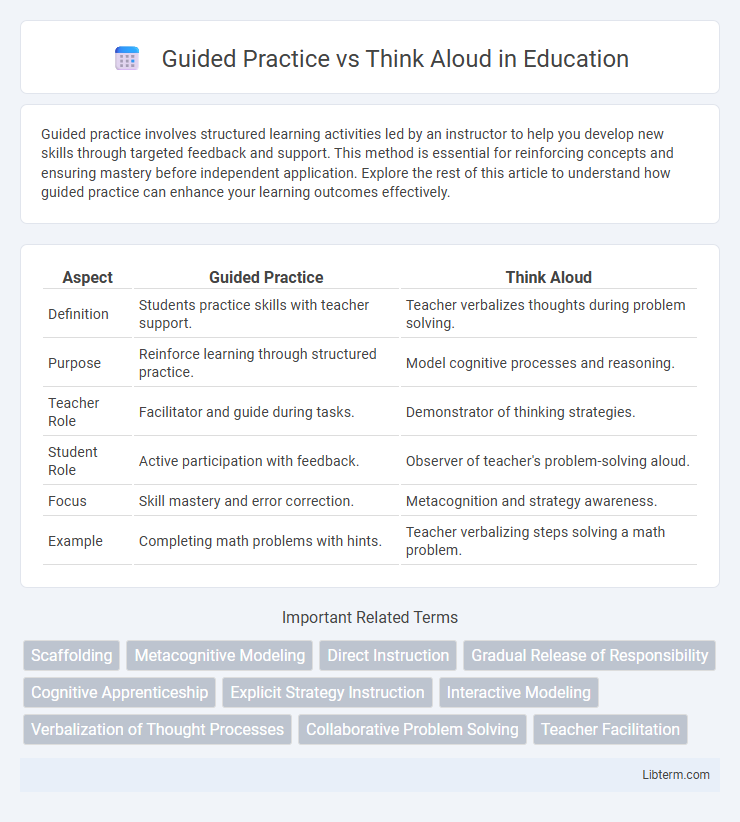Guided practice involves structured learning activities led by an instructor to help you develop new skills through targeted feedback and support. This method is essential for reinforcing concepts and ensuring mastery before independent application. Explore the rest of this article to understand how guided practice can enhance your learning outcomes effectively.
Table of Comparison
| Aspect | Guided Practice | Think Aloud |
|---|---|---|
| Definition | Students practice skills with teacher support. | Teacher verbalizes thoughts during problem solving. |
| Purpose | Reinforce learning through structured practice. | Model cognitive processes and reasoning. |
| Teacher Role | Facilitator and guide during tasks. | Demonstrator of thinking strategies. |
| Student Role | Active participation with feedback. | Observer of teacher's problem-solving aloud. |
| Focus | Skill mastery and error correction. | Metacognition and strategy awareness. |
| Example | Completing math problems with hints. | Teacher verbalizing steps solving a math problem. |
Introduction to Guided Practice and Think Aloud
Guided Practice involves active student engagement with immediate teacher feedback, reinforcing learning through structured support and gradual release of responsibility. Think Aloud is a metacognitive strategy where teachers verbalize their thought processes during problem-solving, modeling cognitive skills and promoting deeper understanding. Both techniques enhance comprehension but serve distinct roles: Guided Practice focuses on skill acquisition while Think Aloud emphasizes reasoning and self-regulation.
Defining Guided Practice
Guided Practice involves structured learning activities where instructors provide support and immediate feedback as learners apply new skills or concepts. This method enhances skill acquisition by combining active participation with expert guidance, ensuring students gradually develop independence. Unlike Think Aloud, which focuses on verbalizing thought processes, Guided Practice emphasizes hands-on interaction under supervision.
Understanding the Think Aloud Strategy
The Think Aloud strategy enhances comprehension by having learners verbalize their thought processes while engaging with material, promoting metacognitive awareness and self-monitoring. This technique allows educators to model expert thinking patterns, making abstract reasoning explicit and accessible. Unlike Guided Practice, which centers on structured skill application, Think Aloud prioritizes cognitive insight, enabling students to internalize problem-solving frameworks.
Key Differences Between Guided Practice and Think Aloud
Guided Practice involves structured, step-by-step support where learners actively apply skills under instructor guidance, promoting skill mastery through direct feedback. Think Aloud emphasizes verbalizing thoughts and reasoning processes aloud during problem-solving, enhancing metacognitive awareness and understanding. The key difference lies in Guided Practice's focus on skill application with scaffolded support, while Think Aloud prioritizes revealing cognitive strategies to improve self-regulation and comprehension.
Advantages of Guided Practice
Guided Practice offers learners structured support, enabling immediate feedback and correction, which enhances skill acquisition and reduces errors. This approach promotes active participation, reinforcing understanding through hands-on application under teacher supervision. By scaffolding complex tasks, Guided Practice fosters confidence and gradual independence in mastering new concepts.
Benefits of Using Think Aloud in Learning
Think Aloud enhances metacognitive skills by making students' thought processes transparent, enabling teachers to identify misconceptions and tailor instruction effectively. This method promotes active engagement and deeper comprehension as learners verbalize their reasoning, fostering critical thinking and self-regulation. Research indicates that using Think Aloud strategies improves problem-solving abilities and retention compared to guided practice alone.
When to Use Guided Practice vs Think Aloud
Guided Practice is most effective when learners need structured support to apply new concepts and develop skills through active participation and feedback. Think Aloud is ideal during initial stages of instruction to model cognitive processes and demonstrate problem-solving strategies in real-time. Using Guided Practice after Think Aloud helps reinforce understanding by allowing learners to practice independently while receiving targeted guidance.
Practical Examples in the Classroom
Guided practice involves students actively working through tasks with teacher support, such as solving math problems step-by-step under supervision to reinforce skills. Think aloud requires teachers verbalizing their cognitive process during problem-solving, like explaining reasoning while annotating a text, helping students model critical thinking. Combining both methods enhances comprehension, for instance, guiding students through writing an essay while articulating thought strategies aloud to foster deeper understanding.
Integrating Both Strategies for Effective Instruction
Integrating guided practice with think aloud techniques enhances instructional effectiveness by combining active student engagement with modelled cognitive processes. Guided practice allows learners to apply new skills with support, while think aloud provides insight into expert reasoning and problem-solving strategies. Together, these methods foster deeper comprehension and skill mastery by promoting interactive learning and metacognitive awareness.
Conclusion: Choosing the Right Approach for Your Learners
Selecting between Guided Practice and Think Aloud depends on learner needs and instructional goals, with Guided Practice offering hands-on skill reinforcement and Think Aloud promoting metacognitive awareness. Educators should analyze learner engagement, cognitive load, and content complexity to tailor methods effectively. Combining both strategies can maximize comprehension and skill acquisition by addressing diverse learning styles.
Guided Practice Infographic

 libterm.com
libterm.com